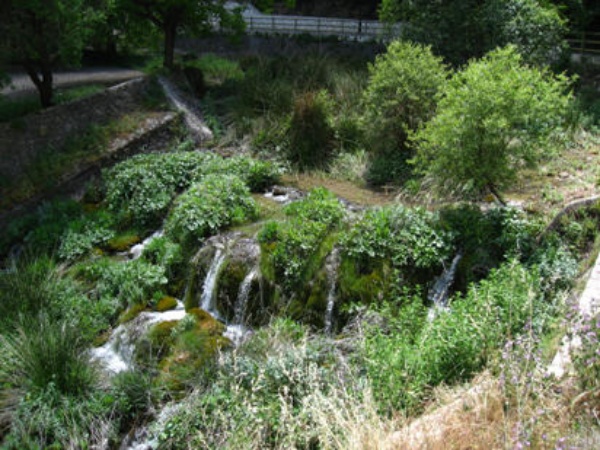
Taibilla River. Nerpio
Flora
The vegetation of the Segura demarcation, despite its apparent scarcity of species, is very rich in taxa, ranging from species adapted to extremely dry conditions to others typical of high mountains. This variability, both climatic, orographic, and lithological, makes the Segura basin present a great variety of diverse species and habitats.
The vegetation found in the Segura Hydrographic Confederation could be classified into the following areas:
- Altiplano (Jumilla, Yecla southern part of Albacete):
-
In general lines in the mountainous and stony solanas there are spartizales or scrub-spartizales. Aleppo pines are more abundant in shady areas, and may appear in some sunny areas. In certain mountain ranges, such as the Sierra de Salinas and del Carche, masses of pine forests appear along with some gall oaks. One of the best-preserved oak groves in the Murcia Region is present in this last mountain range.
On the Rambla de Tobarrillas the Olmeda stands out; in the Sierra Larga, there are some broad pine forest formations, and in the Sierra del Serral and Monte de Santa Ana, optimal areas appear for the mastic. The agricultural land is destined for vineyards, almonds and cereals.
- Central-West Zone (western part of Lorca and Puerto Lumbreras):
-
It presents large areas with rainfed crops and grasslands, scrub and spartiza, with some pine forests in the Sierras del Gigante and Almirez; irrigated crops appear in the fertile plain of the Guadalentín River.
- In the eastern zone (Cartagena, La Unión, Mazarrón, Águilas, Pulpí and part of Alicante):
-
Aquatic ecosystems predominate: wetlands, brackish lagoons, salt marshes and salt flats, with species such as Limonium, Caralluma, Periploca, Maytenus, and Chamaerops, as well as the endemism Tetraclinis articulata.
In the Regional Park of Calblanque, Monte de las Cenizas and Peña del Águila we must mention the pine forests of Monte de las Cenizas, as well as the wild olive trees. - Center-East:
-
The heart of palm stands out in Ricote, Ojós and Blanca; heather in the Sierra Cantón; the taray in the Rambla del Ajauque and rocky vegetation in the Canyon of Almadenes.
In the Sierra de la Pila stand out pine forests, junipers and holm oaks with endemisms such as Anagallis tenella. In the Sierra de Ricote there are chaparral formations with mastic and blackthorn. In the Sierra de Carrascoy appears the best preserved wet Mediterranean holm oak in Murcia. In the Majal Blanco there are some cork oaks, and towards the Sierra de la Cresta del Gallo there are large areas with pine forests, palm hearts, mastic, esparto grass, thyme and rosemary.
On the boulevards you can see myrtle, oleander, reed, hackberry and elm, as well as tall scrub brush and mastic, low brush scrub and wormwood in the lower parts. - Central Zone:
-
We must mention the presence of gall oaks and holm oaks in the Sierra de Pedro Ponce-Cambrón, along with pine groves with mastic and kermes oak. In Totana the palm heart appears. In Sierra Espuña you can see stands with gall, blackberry, maple and strawberry trees, with Caralluma europaea in the lower parts and orchids in the upper parts.
- Northwest Zone:
-
It is characterized by the presence of holm oak (holm oak), Aleppo pine and juniper. In particular, the laricio pine appears in the Sierra de la Muela; the gall oak in the shady Sierra Revolcadores and El Nevazo; Caralluma munbyana in Caravaca; the juniper dwells in the Revolcadores, Mojantes, Gavilán and La Muela mountain ranges; the endemic species Sarcocapnos baetica in Benizar, Sierra de la Muela and Pliego; well-preserved oak groves in Los Odres, Cañada de la Cruz and Puntal de la Covacha .; juniper juniper (Juniperus thurifera) in the Sierras de Moratalla forming forests in the vicinity of El Sabinar, La Zarza and Calar de la Santa.
- The head of the Segura basin:
-
There are extensive forests of laricio pine, in the high levels, as well as negral and carrasco in the other levels. There are important endemisms such as "Violeta de Cazorla", Hormatofila, Geranium de Cazorla, Aquilegia Cazorlensis, Narcissus Longispatus. There are holly trees in restricted areas, and very scattered throughout the park we find yew trees. Both species are highly protected by the danger of extinction. In the north of Sierra Segura we find magnificent gall oaks and melojos or rebollos. It is very important to highlight that in the Sierra de Segura, there is a carnivorous plant, unique in the world, the "Pinguicola Vallisneriifolia".
- Mar Menor region:
-
With mainly aquatic ecosystems, Maytenus senegalensis, Periploca angustifolia appear in coastal areas, and Caralluma europaea in San Javier.
Focusing on the vegetation associated with watercourses, we must highlight its great variability, due to the different regimes of the watercourses of the basin, existing from stretches of river (mainly the Segura and the World) with abundant flow practically all year round, on boulevards where water only occasionally circulates.
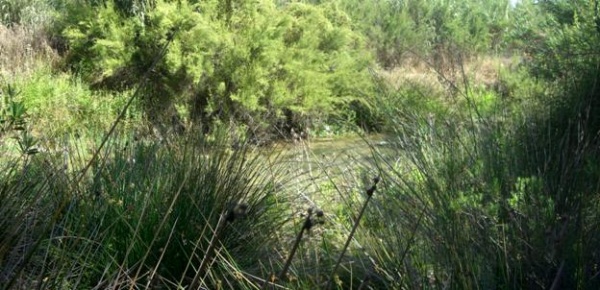
Vegetation characteristic of the banks of the Segura river
In these permanent courses, different species of willows (Salix sp), poplars (Populus sp.) and olmedas (Ulmus minor) stand out, being represented in the courses or permanent species such as tarays (Tamarix sp.) and oleanders ( Nerium oleander).
The most common macrophytes are the eneas (Typha domingensis), the reed (Phragmites australis) and the reeds (Juncus sp.).
Fauna
In the Sierra del Segura there are many endemic species, among which the Valverde lizard stands out, a species that is only found in the Sierra de Cazorla and Segura.
Regarding fish life, it varies greatly according to the river sections. Salmonid species are found in the upper reaches, especially of the Segura and Mundo river beds, very demanding in the quality of the waters, highlighting the common trout, reduced by the introduction of rainbow trout.
But most of the channels of the Segura demarcation, those with lower flow or higher temperature, are populated by cyprinid species such as chubs and barbels.
Apart from these populations, there are also several exotic species that, due to their use for sport fishing, have entered the ecosystem and pose a threat to native fauna. Among them we can highlight the pike, the black-bass, the walleye, the percasol, the catfish, as well as the American crab, which has managed to decimate the population of the native crab.
It is also interesting to highlight the presence of the fartet, a species that lives in transitional and coastal waters, and which is currently at serious risk of extinction.
Wetlands have not been generally considered as water bodies, unless the water surface meets the criteria set out for its classification as a lake-type water body. Note that the non-consideration of wetlands as water bodies in the present Hydrological Plan proposal does not mean their lack of protection under the WFD, since they have been incorporated into the register of protected areas.
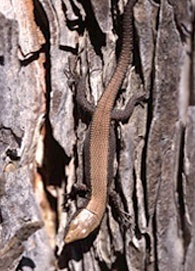
Valverde lizard
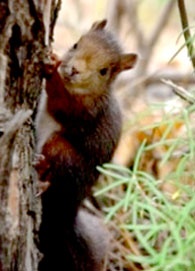
Segura squirrel
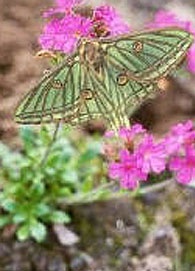
Isabelle butterfly
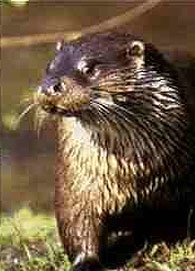
Otter
Marine environment
Regarding the marine and coastal environment, it should be noted that favored by its geographical location, landscape heterogeneity and habitats, the seabed of the Segura Hydrographic Confederation hosts a great diversity of organisms. This area is characterized by a great wealth of benthos (a set of plant and animal organisms that lives in close relationship with the seabed).
It is worth noting the existence of important meadows of Posidonia Oceánica. The installation of this species on a sandy bottom makes an unstable substrate transform into a structured one, where a greater number of species find a place of fixation, refuge and food. This species is seriously threatened in the Mediterranean, due to its great sensitivity to anthropogenic pollution due to water pollution and coastal works.
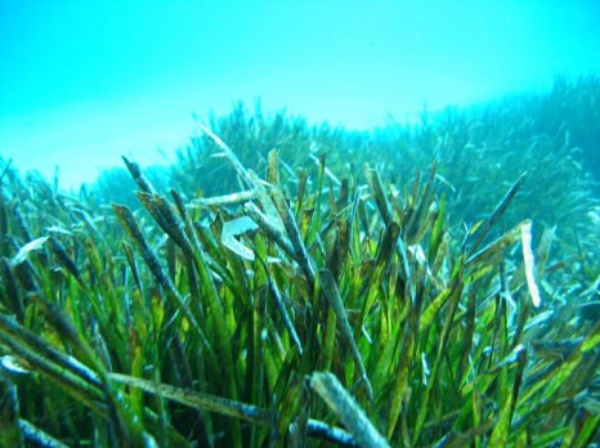
Oceanic Posidonia Prairie
The seabed of the Segura Hydrographic Confederation can be divided into two main groups: the rocky bottoms and the soft bottoms. In the former epibenthic species predominate. In shallow water, algal species dominate and in deep water, animal species. In the soft bottoms, there are few epibiont organisms and a large number of endobiont organisms, with a reduced number of plant species that can fix and stabilize the substrate. Coarse-grained bottoms are poor in organic matter and bacteria and rich in interstitial organisms. Fine-grained bottoms are rich in organic matter and poor in interstitial organisms.
The most outstanding species present in the areas of the Segura Hydrographic Confederation are some types of algae such as Cystoseira Zosteroides or Phymatolithon Calcareum. In addition to Posidonia oceanica, some phanerogamic plants such as Zostera Noltii stand out. There is a wide variety of echinoderms such as the common hedgehog, very abundant in rocky areas and in the Posidonia meadows. The existing variety of fish is very extensive, highlighting the grouper and the eel.
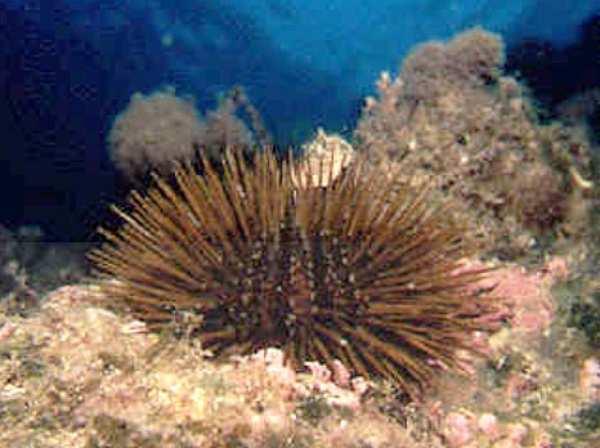
Common sea urchin
It is also interesting to highlight the presence of the fartet, a species that lives in coastal transitional waters, and which is currently at serious risk of extinction.
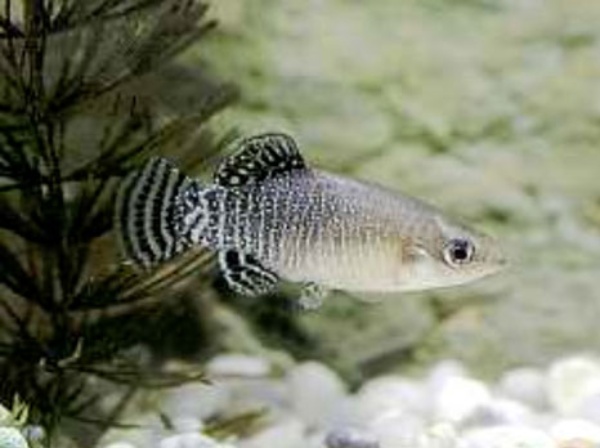
Fartet



